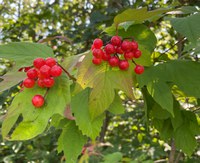Dakota Gardener: End of the year reporting
(Click an image below to view a high-resolution image that can be downloaded)
By Joe Zeleznik, forester
NDSU Extension
For the next couple of weeks, I’ll be working on my end-of-the-year reports. It’s a great time to reflect on what went well and what could have gone better. I thought that the reports would provide a good foundation for this month’s column.
But let’s face it – reports are boring. Instead, how about some highlights!
This was the 30th straight year that I planted at least one tree in the spring. In 2022, I helped plant nearly a dozen new trees at the Myra Arboretum near Larimore, in western Grand Forks County. I’m excited to see how the Northern Empress® Japanese elm does in the coming years. This cultivar is an NDSU release that has outstanding burgundy color in the fall. Check out Myra next summer; it’s a great place to visit.
During late summer, I helped some colleagues at the University of Minnesota on a genetics study of our native highbush cranberry, also called American cranberrybush. This is not the cranberry that we eat at Thanksgiving. Instead, it’s a viburnum. The fruit is a beautiful red color and very tart. The study aims to determine how closely related the American cranberrybush and the European cranberrybush are. The berries from the European shrub are poisonous.
On a totally different note, diagnosing tree health problems takes up a lot of my time each year. This past summer was no different.
Drought-related tree stress dominated in 2022. Besides direct damage from the drought, two pests in particular increased this year – bronze birch borer (BBB) and Valsa canker of spruce.
Both of these pests are strongly associated with drought. If there’s enough moisture, the trees can fight off the pests. Therefore, management is pretty simple – prevent the pests in the first place by properly watering your birch trees (BBB) or spruce trees (Valsa).
On a positive note, emerald ash borer has still NOT been found in North Dakota. Thank you to all the cooperators out there who’ve been keeping a great lookout for this pest. Someday, when this destructive insect establishes in North Dakota, it will have the potential to substantially change our native forests, urban forests and shelterbelts. Thanks especially to the North Dakota Department of Agriculture and the North Dakota Forest Service for their efforts at insect monitoring and trapping.
All end-of-the-year reports include a section on next year’s plans and goals. I enjoy that part of the process as it allows me to think big. It’s funny though – the calendar year is different from the fiscal year. And the state’s fiscal year is different from the Federal fiscal year. It can get a bit complicated.
Do trees have a fiscal year? Sort of.
The amount that trees grow in our region is strongly linked to available moisture. However, soil moisture and its availability do not follow the calendar year. Instead, they follow the “water year,” also known as a hydrologic year.
Precipitation that falls in October through December of a given year isn’t going to help trees grow that year. Instead, it’s best-linked to growth the following year. Thus, the amount of precipitation in the water year – October through September of the following year – is the best predictor of tree growth in our area.
It’s like a carryover from one year’s annual budget to the following year.
May you have a big carryover of peace and joy in your annual budget for 2023. Wishing you all a great new year.
NDSU Agriculture Communication – Dec. 13, 2022
Source: Joe Zeleznik, 701-730-3389, joseph.zeleznik@ndsu.edu
Editor: Kelli Anderson, 701-231-6136, kelli.c.anderson@ndsu.edu




